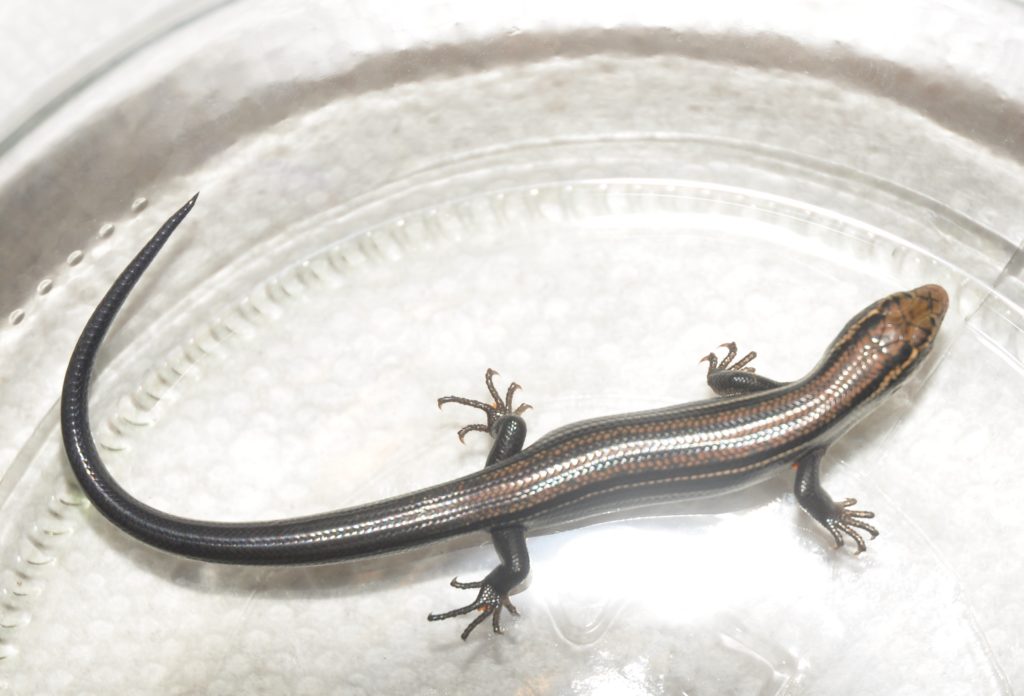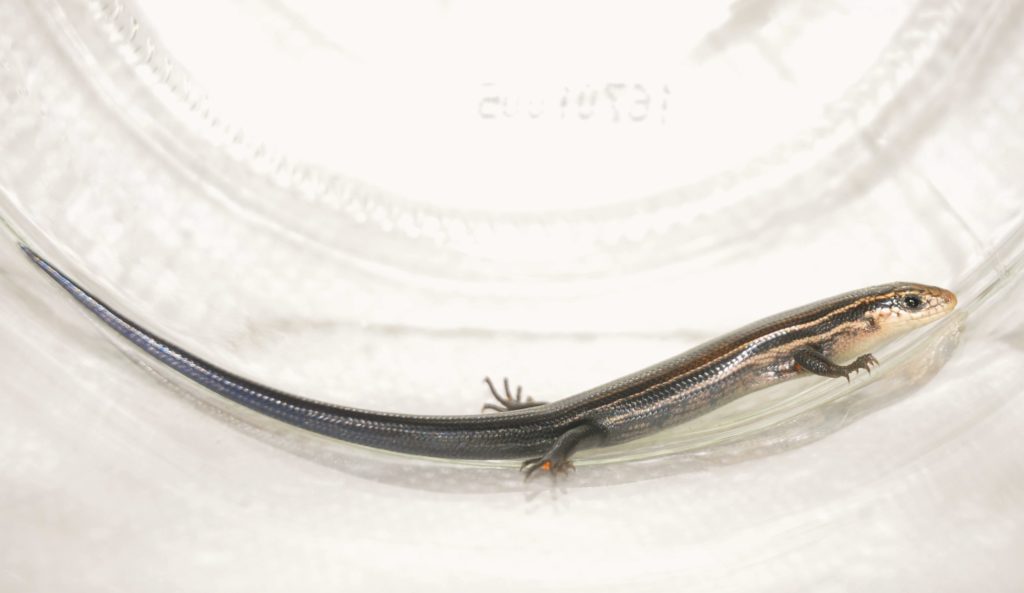Photography courtesy of Lowell Washburn, all rights reserved.
Dig your way through a few fresh gopher mounds, and you’re likely to find just about everything but gophers. Discoveries may include napping toads, salamanders, garter snakes, and an impressive array of multi-legged invertebrate wildlife. During early fall, the excavations can occasionally yield something a bit more exotic. That’s what happened earlier this week when Carol and I were poking around the Beaver Dam Wildlife Area.
Located in Northern Iowa’s Cerro Gordo County, Beaver Dam is a DNR managed, restored wetland complex. The wetland area’s grassy uplands are currently loaded with fresh pocket gopher diggings; and the moist jet-black prairie soil was just begging to be explored. As I sifted through the fifth or sixth mound, the pulverized sod bore an unexpected treasure when a shiny, wriggling creature suddenly burst to the surface. I could scarcely believe my eyes. The animal was a tiny reptile known as the prairie skink – a seldom seen species that I haven’t encountered in decades. It was like seeing an old friend.

Although I was thrilled by the rare sighting, it was obvious that the skink had no desire to make my acquaintance. Instead, it immediately sped toward the edge of the disturbed mound. If the fleeing herpitile made it to the adjacent prairie grasses, it would vanish in a blink. Reacting instinctively, I lunged to the ground and quickly secured the fleeing creature inside my closed fist. The event was so unusually noteworthy that we immediately suspended actions headed back to the truck to admire and photo document our prize.
For those unfamiliar with the species, prairie skinks represent one of only five, seldom seen lizard species that inhabit our state. Prairie skinks have slender multi-striped bodies, rarely grow to a length of more than six or seven inches and are most often found on open prairies associated with natural wetlands. Juvenile skinks are easily distinguished from adults by their bright – almost fluorescent — blue tails. The theory is that the bright color directs predators toward the retreating lizard’s wriggling tail and away from its body. The skink I captured was a four-inch, blue tailed juvenile.
Regardless of age, the tails of all skinks are easily detached from their bodies. A simple touch may be all that’s required to turn a retreating lizard into an instant bobtail. It’s an effective tactic that leaves four-legged predators and overly curious boys, with nothing to show but a crazily gyrating, separated appendage. The mere sight of the writhing tail is enough to give most folks the willies. Unlike the severed body parts of most animals, the skink’s unique tail will regenerate; giving the speedy reptile a second chance of evading would be captors.
Although prairie skinks have been documented from a handful of locations across the western half of Iowa; their true status is unknown. Some ‘Lizard Heads’ think the species is rare and, due to development, is likely becoming more so. Others suspect that skinks may be more abundant than we realize. The creatures are out there, they say. But like Sasquatch, no one knows where. All I can say is that I have known wildlife professionals who spent their entire careers in what should have been prime skink habitats, but never laid eyes on a single lizard.
When I was a youngster, my grandparents owned what is now the center pool of Cerro Gordo county’s Mallard Marsh. Loaded with ducks, frogs, herons and other natural wonders, it was my favorite childhood playground. The marshy terrain and somewhat gravely soil harbored skinks then and although my last sighting occurred more than twenty years ago, I suspect a population still exists. It seems likely that additional, but yet to be identified, skink populations may exist elsewhere; especially in the grassy uplands on some of North Iowa’s restored wetland complexes – such as the Beaver Dam.

Final Thoughts: After capturing the Beaver Dam skink, it took us around ten minutes or so to return to the truck. Upon carefully releasing our treasure into a scientifically designed photo chamber – otherwise known as an empty jar – I was amazed to discover that the juvenile’s bright blue tail had changed to a darker, much less spectacular earth tone. The skink’s chameleon-like color change was something I had never heard of before. After obtaining a number of voucher photos, I returned the young skink – complete with tail — to its gopher mound habitat.
The fact that an isolated tract of restored wetland is able to reestablish a viable population of successfully reproducing skinks certainly lends optimism for the future survival of one of our most unique, but rarely seen, forms of Iowa wildlife. So why should anyone care about the future of an obscure reptile that hardly anyone is ever going to see anyway? The short answer is that the survival of any indicator species is important to all of us. The greater the biological diversity; the healthier the environment.
LW

 Tom Cope
Tom Cope Sue Wilkinson
Sue Wilkinson Susan Judkins Josten
Susan Judkins Josten Rudi Roeslein
Rudi Roeslein Elyssa McFarland
Elyssa McFarland Mark Langgin
Mark Langgin Adam Janke
Adam Janke Joe Henry
Joe Henry Kristin Ashenbrenner
Kristin Ashenbrenner Joe Wilkinson
Joe Wilkinson Dr. Tammy Mildenstein
Dr. Tammy Mildenstein Sean McMahon
Sean McMahon